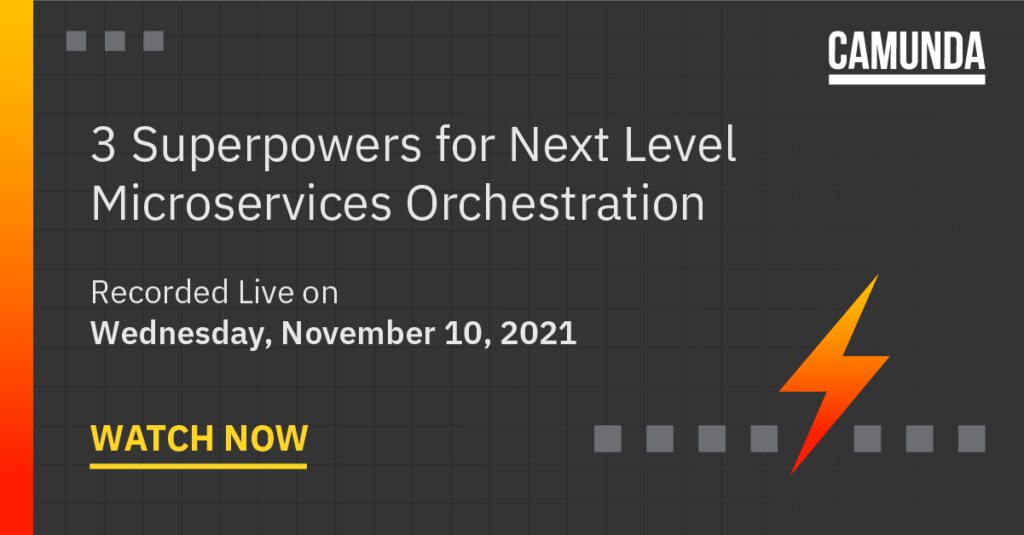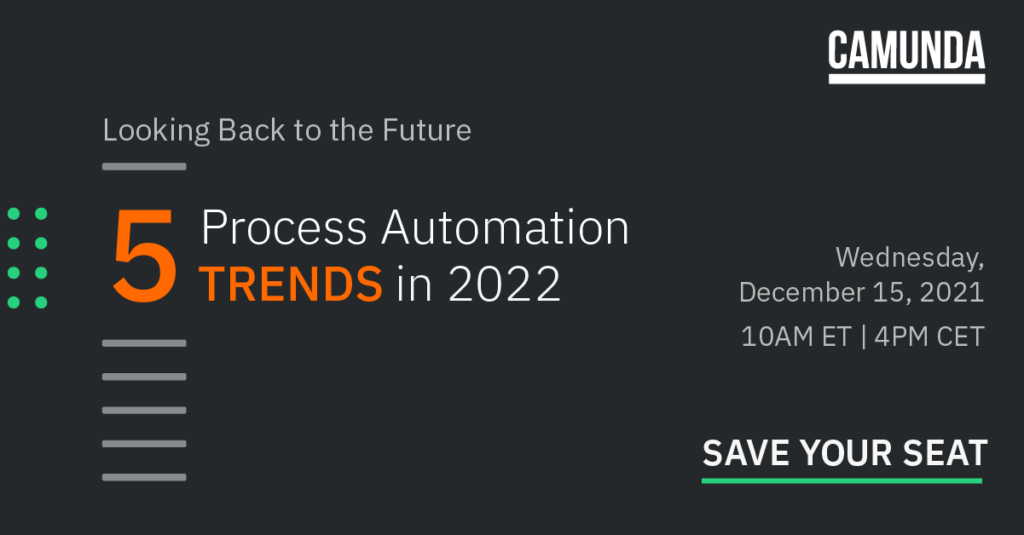*Camunda Platform 8, our cloud-native solution for process orchestration, launched in April 2022. Images and supporting documentation in this post may reflect an earlier version of our cloud and software solutions.
On Nov. 10, we presented the 3 Superpowers for Next Level Microservices Orchestration webinar, which revealed continuous delivery, a cloud-native mindset and BizDevOps as the key abilities needed to save the day with exceptional process automation. As usual, there were more questions asked than we had time to answer, so we’d like to share them here.
If you’d like to learn more about microservices orchestration, you can watch the webinar on demand, or get back to basics with the Ultimate Guide to Process Automation and Microservices.
You Asked, We Answered
Q: Where can I learn more about the process automation map?
A: I’m glad you asked! The process automation map is something I’m quite excited about. I talked about it briefly in my CamundaCon keynote, and there are some more slides on it in this talk I recently did. Here’s a sneak peek draft of an upcoming blog I wrote. You get to view it before it’s published within the next few weeks.
Q: In my organization, it’s required to implement DevOps for the deployment of Camunda and other technologies. Do you have any recommendations?
A: First of all, I don’t think you can “implement DevOps.” For me, DevOps is foremost a mindset and embodies a couple of practices introduced in the Continuous Delivery book. Or as Wikipedia puts it, “DevOps is a set of practices that combines software development (Dev) and IT operations (Ops). It aims to shorten the systems development life cycle and provide continuous delivery with high software quality. DevOps is complementary with Agile software development; several DevOps aspects came from the Agile methodology.”
For Camunda projects, this typically means that solutions to automate processes can be hooked into those practices. The most prominent ones being automated testing and continuous integration/continuous deployment (CI/CD) pipelines.
This heavily depends on your specific stack. If you use Java, for example, a best practice stack could be composed of Spring Boot, JUnit, Camunda, and whatever you need to integrate your services.
Q: How can I migrate Pega to Camunda and what are the benefits of it? Does it need any prior knowledge of Java?
A: This is a loaded question. The gist is that Camunda focuses on its open architecture and developer-friendliness, in contrast to Pega that wants to be a low-code solution for the business.
Assessing the ability to migrate involves many factors that makes it difficult to provide a crisp generic answer. But this blog post might be an interesting starting point, Migrating processes from Pega to Camunda – Step-by-step Tutorial.
Camunda does not necessarily require Java knowledge in all cases, and especially with Camunda Cloud. You can easily use other programming languages as well. But you do need developers, for sure. Moreover, even though we’re working hard to become fully polyglot, it’s still pretty easy to spot that we have Java roots.
Q: Can you provide details of Camunda Cloud pricing?
A: I simply quote our homepage for this one. 🙂
Camunda Cloud pricing can be found on our product comparison page. Click here to contact someone for additional information.
Q: Does the BPMN engine perform well enough to execute service flows efficiently in high workload environments?
A: Short answer: Yes.
Long answer: We have two products. Camunda Platform requires a relational database, but so far we could push it to almost every use case required. See Performance & Scalability. And we have a cloud-native workflow engine for Camunda Cloud, which is truly horizontally scalable. At CamundaCon, one of our customers talked about a process that must be able to process two million payments per hour. I’ll rest my case.
Q: Is it necessary to be a developer (Java or other) to use Camunda Platform as a BPM tool?
A: Yes (exceptions confirm the rule).
Q: Can we get some insight on MicroApp orchestration instead of just microservice orchestrator?
A: While I love that you ask about MicroApps, the question is pretty generic. You can join our Camunda Community to reach out to us with a specific example and we’d be more than happy to discuss it with you!
Ready for more? Attend our upcoming webinar, Looking Back to the Future: 5 Process Automation Trends in 2022, on Wednesday, Dec. 15, to hear about the top five trends that will lead the digital transformation charge in the coming year.


